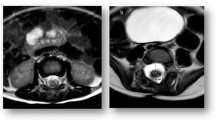Abstract
Objectives
To analyze the results after surgery for spinal cord lipomas.
Methods
The authors report their results of management of 63 non consecutive random children with spinal cord lipomas treated over a period from 2001 to 2005, at the All India Institute of Medical Sciences, New Delhi, India, a tertiary care neurosurgical centre.
Results
There were 63 cases consisting of 32 (52%) conus lipomas, 14 (22%) filum lipomas, 14 (22%) lipomeningomyelocele (lipoMMC), 2 (2.5%) cases of lipomyelocystocele and one (1.5%) case of mixed lipoma. None of the patients who were asymptomatic before surgery deteriorated neurologically, irrespective of the type of lipoma till the last follow up. In those patients with preexisting neurological deficits, the improvement in motor, sensory and bladder abnormalities was only to an extent of 15%, 16% and 21% respectively. None of the children with preexisting neurological deficit regained overall normal function. Nevertheless, the improvement in symptoms after surgery made the patients lead a better social life. Only 6% of patients developed deterioration in neurological function after surgery, all of them occurring in patients already having pre-operative deficits.
Conclusions
The authors recommend prophylactic surgery which is safe and effective in preventing neurological deficits, irrespective of the type of lipoma. Most of the patients benefit only to some extent even after surgery, once they develop neurological dysfunction. A close long term follow up is recommended in order to detect neurological deterioration even in children operated prophylactically.
Similar content being viewed by others
References
La Marca F, Grant JA, Tomita T, McLone DG. Spinal lipoma in children: Outcome of 270 procesures. Pediatr Neurosurg 1997; 26: 8–16.
Pierre-Kahn A, Zerah M, Renier D, Cinalli G, Sainte-Rose C, Lellouch-Yubiana A et al. Congenital lumbosacral lipomas. Childs Nerv Syst 1997; 13: 298–334.
Kulkarni AV, Pierre-Kahn A, Zerah M. Conservative management of asymptomatic spinal lipomas of the conus. Neurosurgery 2004; 54: 868–873.
Van Calenbergh F, Vanvolsem S, Verpoorten C, Lagae L, Casaer P, Plets C: Results after surgery for lumbosacral lipoma: the significance of early and late worsening. Childs Nerv Syst 1999; 15: 439–442.
Xenos C, Sgouros S, Walsh R, Hockley A. Spinal lipomas in children. Pediatr Neurosurg 2000; 32: 295–307.
Bulsara KR, Zomorodi AR, Villavicencio AT, Fuchs H, George TM. Clinical outcome differences for lipomyelomeningoceles, intraspinal lipomas, and lipomas of the filum terminale. Neurosurg Rev 2001; 24: 192–194.
Morimoto K, Takemoto O, Wakayama A. Spinal lipomas in children—surgical management and long-term follow-up. Pediatr Neurosurg 2005; 41: 84–87.
Brunberg JA, Latchaw RE, Kanal E, Burk L, Albright L: Magnetic resonance imaging of spinal dysraphism. Radiol Clin North Am 1988; 26: 181–205.
Sato K, Shimoji T, Sumie H, Yaguchi K, Kuru Y, Ishii S. Surgically confirmed myelographic classification of congenital intraspinal lipoma in the lumbosacral region. Childs Nerv Syst. 1985; 1: 3–11.
Scatliff JH, Kendall BE, Kingsley DPE, Britton J, Grany DN, Hayward RD. Closed spinal dysraphism: analysis of clinical, radiological, and surgical findings in 104 consecutive patients. AJR Am J Roentgenol 1989; 152: 1049–1057.
Li YC, Shin SH, Cho BK, Lee MS, Lee YJ, Hong SK et al. Pathogenesis of lumbosacral lipoma: a test of the “premature dysjunction” theory. Pediatr Neurosurg 2001; 34: 124–30.
Koyanagi I, Iwasaki Y, Hida K, Abe H, Isu T, Akino M: Surgical treatment of syringomyelia associated with spinal dysraphism. Childs Nerv Syst 1997; 13: 194–200.
Sarwark JF, Weber DT, Gabrieli AP, McLone DG, Dias L: Tethered cord syndrome in low motor level children with myelomeningocele. Pediatr Neurosurg 1996; 25: 295–301.
Herman JM, McLone DG, Storrs BB, Dauser RC. Analysis of 153 patients with myelomeningocele or spinal lipoma reoperated upon for a tethered cord. Presentation, management and outcome. Pediatr Neurosurg 1993; 19: 243–9.
Kanev PM, Bierbrauer KS. Reflections on the natural history of lipomyelomeningocele. Pediatr Neurosurg 1995; 22: 137–140.
Dorward NL, Scatliff JH, Hayward RD. Congenital lumbosacral lipomas: pitfalls in analysing the results of prophylactic surgery. Childs Nerv Syst 2002; 18: 326–332.
Kang HS, Wang KC, Kim KM et al. Congenital lumbosacral lipomas: pitfalls in analysing the results of prophylactic surgery. Childs Nerv Syst 2002; 18: 326–332.
Byrne RW, Hayes EA, George TM, McLone DG. Operative resection of 100 spinal lipomas in infants less than 1 year of age. Pediatr Neurosurg 1995; 23: 182–186.
Chapman PH, Frim DM. Symptomatic syringomyelia following surgery to treat retethering of lipomyelomeningoceles. J Neurosurg 1995; 82: 752–755.
Cornette L, Verpoorten C, Lagae L, Van Calenbergh F, Plets C, Vereecken R et al. Tethered cord syndrome in occult spinal dysraphism: timing and outcome of surgical release. Neurology 1998; 50: 1761–1765.
Cochrane DD, Finley C, Kestle J, Steinbok P The patterns of late deterioration in patients with transitional lipomyelomeningocele. Eur J Pediatr Surg 2000; 10: 13–17.
Author information
Authors and Affiliations
Rights and permissions
About this article
Cite this article
Kasliwal, M.K., Mahapatra, A.K. Surgery for spinal cord lipomas. Indian J Pediatr 74, 357–362 (2007). https://doi.org/10.1007/s12098-007-0060-8
Received:
Accepted:
Published:
Issue Date:
DOI: https://doi.org/10.1007/s12098-007-0060-8




